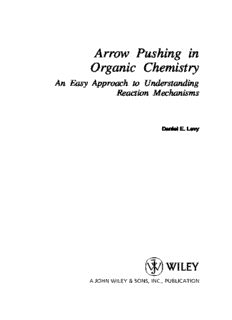
Arrow-Pushing in Organic Chemistry PDF
Preview Arrow-Pushing in Organic Chemistry
Arrow Pushing in Organic Chemistry An Easy Approach to Understanding Reaction Mechanisms Daniel E. Levy Arrow Pushing in Organic Chemistry Arrow Pushing in Organic Chemistry An Easy Approach to Understanding Reaction Mechanisms Daniel E. Levy Copyright#2008byJohnWiley&Sons,Inc.Allrightsreserved PublishedbyJohnWiley&Sons,Inc.,Hoboken,NewJersey PublishedsimultaneouslyinCanada Nopartofthispublicationmaybereproduced,storedinaretrievalsystem,ortransmittedinanyformorby anymeans,electronic,mechanical,photocopying,recording,scanning,orotherwise,exceptaspermitted underSections107or108ofthe1976UnitedStatesCopyrightAct,withouteitherthepriorwritten permissionofthePublisher,orauthorizationthroughpaymentoftheappropriateper-copyfeetothe CopyrightClearanceCenter,Inc.,222RosewoodDrive,Danvers,MA01923,(978)750-8400,fax(978) 750-4470,oronthewebatwww.copyright.com.RequeststothePublisherforpermissionshouldbe addressedtothePermissionsDepartment,JohnWiley&Sons,Inc.,111RiverStreet,Hoboken,NJ07030, (201)748-6011,fax(201)748-6008,oronlineathttp://www.wiley.com/go/permission. LimitofLiability/DisclaimerofWarranty:Whilethepublisherandauthorhaveusedtheirbestefforts inpreparingthisbook,theymakenorepresentationsorwarrantieswithrespecttotheaccuracyor completenessofthecontentsofthisbookandspecificallydisclaimanyimpliedwarrantiesof merchantabilityorfitnessforaparticularpurpose.Nowarrantymaybecreatedorextendedbysales representativesorwrittensalesmaterials.Theadviceandstrategiescontainedhereinmaynotbesuitable foryoursituation.Youshouldconsultwithaprofessionalwhereappropriate.Neitherthepublishernor authorshallbeliableforanylossofprofitoranyothercommercialdamages,includingbutnotlimitedto special,incidental,consequential,orotherdamages. Forgeneralinformationonourotherproductsandservicesorfortechnicalsupport,pleasecontactour CustomerCareDepartmentwithintheUnitedStatesat(800)762-2974,outsidetheUnitedStatesat(317) 572-3993orfax(317)572-4002. Wileyalsopublishesitsbooksinvarietyofelectronicformats.Somecontentthatappearsinprintmaynotbe availableinelectronicformat.FormoreinformationaboutWileyproducts,visitourwebsiteat www.wiley.com. LibraryofCongressCataloging-in-PublicationDataisavailable. ISBN 978-0-470-17110-3 PrintedintheUnitedStatesofAmerica 10 9 8 7 6 5 4 3 2 1 Dedicated to the memoryof Henry Rapoport (1918–2002) Professorof Chemistry, Emeritus Universityof California — Berkeley A true teacherand mentor Contents PREFACE xi ACKNOWLEDGMENTS xiii ABOUT THE AUTHOR xv 1. Introduction 1 1.1 Definition of Arrow Pushing 1 1.2 Functional Groups 5 1.3 Nucleophiles and Leaving Groups 8 1.4 Summary 8 Problems 10 2. Acids 19 2.1 What are Acids? 19 2.2 What is Resonance? 20 2.3 How is Acidity Measured? 23 2.4 Relative Acidities 25 2.5 Inductive Effects 29 2.6 Inductive Effects and Relative Acidities 31 2.7 Relative Acidities of Hydrocarbons 33 2.8 Summary 34 Problems 35 vii viii CONTENTS 3. Bases and Nucleophiles 45 3.1 What are Bases? 45 3.2 What are Nucleophiles? 50 3.3 Leaving Groups 54 3.4 Summary 55 Problems 56 4. S 2 Substitution Reactions 65 N 4.1 What is an S 2 Reaction? 65 N 4.2 What are Leaving Groups? 67 4.3 Where Can S 2 Reactions Occur? 68 N 4.4 S 20 Reactions 71 N 4.5 Summary 73 Problems 74 5. S 1 Substitution Reactions 83 N 5.1 What is an S 1 Reaction? 83 N 5.2 Howare S 1 Reactions Initiated 84 N 5.3 The Carbocation 86 5.3.1 Molecular Structure and Orbitals 86 5.3.2 Stabilityof Carbocations 90 5.4 Carbocation Rearrangements 92 5.4.1 1,2-Hydride Shifts 92 5.4.2 1,2-Alkyl Shifts 93 5.4.3 Preventing Side Reactions 95 5.5 Summary 96 Problems 97 6. Elimination Reactions 101 6.1 E1 Eliminations 101 6.2 E2 Eliminations 104 6.3 How Do Elimination Reactions Work? 105 6.4 Summary 108 Problems 109 7. Addition Reactions 115 7.1 Addition of Halogensto Double Bonds 115 7.2 Markovnikov’s Rule 117 7.3 Additionsto Carbonyls 119 7.3.1 1,2-Additions 119 7.3.2 1,4-Additions 121 7.3.3 Addition–Elimination Reactions 123 7.4 Summary 125 Problems 126
Description: